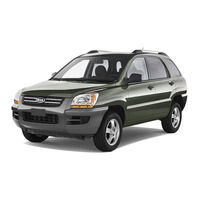
Kia Sportage 2008 Manuals
Manuals and User Guides for Kia Sportage 2008. We have 2 Kia Sportage 2008 manuals available for free PDF download: Owner's Manual, Manual
Kia Sportage 2008 Owner's Manual (351 pages)
Brand: Kia
|
Category: Automobile
|
Size: 6 MB
Table of Contents
-
-
Keys11
-
-
Alarm Stage15
-
-
Door Locks18
-
Window26
-
Seats28
-
Armrest38
-
Load Limiter40
-
-
Side Airbag76
-
Maintenance79
-
Hood89
-
Room Light98
-
Glove Box102
-
Sunglass Holder102
-
Ashtrays103
-
Cup Holder104
-
Sunvisor105
-
Power Socket106
-
Digital Clock107
-
Sunroof109
-
Sunshade111
-
Luggage Net113
-
Tonneau Cover114
-
Roof Rack117
-
Specifications117
-
Antenna118
-
Ignition Switch120
-
Downshifting123
-
Manual Transaxle123
-
Transaxle Ranges126
-
D (Drive)127
-
N (Neutral)127
-
R (Reverse)127
-
Snow Mode128
-
Sports Mode128
-
-
Index134
-
Brake System136
-
Steering Wheel143
-
Tilt Steering144
-
Horn145
-
-
-
TCS off Usage153
-
ESC off Usage156
-
Gauges158
-
Speedometer158
-
Tachometer158
-
Fuel Gauge159
-
Odometer159
-
Trip Computer160
-
Driving Time161
-
Tripmeter161
-
-
-
Air Bag Warning168
-
Compass172
-
Lighting175
-
Lighting Control175
-
Front Fog Light177
-
Turn Signals177
-
-
Defroster182
-
-
Face Position187
-
Floor Position187
-
Air Conditioning190
-
Heating190
-
Ventilation190
-
Manual Operation195
-
Defrost Button200
-
OFF Button201
-
Driving Tips211
-
Before Driving215
-
-
Crossing a Ditch225
-
Driving Uphill232
-
Driving Downhill235
-
Driving in Water240
-
Cargo Weight242
-
-
Trailer Towing243
-
Driving Tips244
-
Hitches245
-
Safety Chains246
-
Trailer Brakes246
-
Backing up247
-
Passing247
-
Parking on Hills249
-
Overloading250
-
Overheating265
-
-
Jump Starting266
-
Push-Starting268
-
-
-
Fuses269
-
Fuse Replacement270
-
Main Fuse271
-
-
Towing276
-
-
Changing Tires283
-
Tire Replacement284
-
Maintenance288
-
Changing Coolant304
-
Drive Belts307
-
Body Lubrication313
-
Tires and Wheels321
-
Tires Care321
-
Tire Rotation323
-
Tread Wear330
-
All Season Tires334
-
Summer Tires334
-
-
Exterior Care337
-
Interior Care340
-
Specifications341
-
Index347
-
Advertisement
Kia Sportage 2008 Manual (227 pages)
Restraint
Brand: Kia
|
Category: Automobile
|
Size: 5 MB
Table of Contents
-
Installation20
-
Operation37
-
Specification153
-
Specification210
Advertisement

